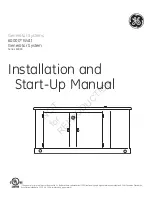
19
Fig 8.1
18
5
Installation
5
Installation
Danger to life due to fire or explosion
Risk of burns due to hot enclosure parts
Mount the inverter in such a way that it cannot be touched
inadvertently.
All electrical installations shall be done in accordance with the local and national
electrical codes. Do not remove the casing. Inverter contains no user serviceable
parts. Refer servicing to qualified service personnel. all wiring and electrical
Installation should be conducted by a qualified service personnel .
Carefully remove the unit from its packaging and inspect for external damage. If
you find any imperfections, please contact your local dealer.
Be sure that the inverters connect to the ground in order to protect property and
personal safety.
The inverter must only be operated with PV generator. Do not connect any other
source of energy to it.
Both AC and DC voltage sources are terminated inside the PV Inverter. Please
disconnect these circuits before servicing.
This unit is designed to feed power to the public power grid (utility) only. Do not
connect this unit to an AC source or generator. Connecting Inverter to external
devices could result in serious damage to your equipment.
When a photovoltaic panel is exposed to light, it generates a DC voltage. When
connected to this equipment, a photovoltaic panel will charge the DC link
capacitors.
Energy stored in this equipment's DC link capacitors presents a risk of electric
shock. Even after the unit is disconnected from the grid and photovoltaic panels,
high voltages may still exist inside the PV-Inverter. Do not remove the casing
until at least 5 minutes after disconnecting all power sources.
Although designed to meet all safety requirements, some parts and surfaces of
Inverter are still hot during operation. To reduce the risk of injury, do not touch
the heat sink at the back of the PV-Inverter or nearby surfaces while Inverter is
operating.
5.2. Selecting mounting location
This is guidance for installer to choose a suitable installation location, to avoid
potential damages to device and operators.
The installation location must be suitable for the inverter's weight and
dimensions for a long period time. (Refer to 3.3)
Do not install the inverter on structures constructed of flammable or
thermolabile materials.
Never install the inverter in environment of little or no air flow, nor dust
environment. That may derate the efficiency of the cooling fan of the inverter.
The Ingress Protection rate is IP65 which means the inverter can be installed
outdoors and indoors.
Do not expose the inverter to direct sunlight, in order to avoid the power and
efficiency derating caused by excessive heating.
The humidity of the installation location should be 0~95% without
condensation.
The ambient temperature should be below 40
to ensure optimal operation.
The installation location must be freely and safely to get at all times.
Vertically installation and make sure the connection of inverter must be
downwards. Never install horizontal and avoids forward and sideways tilt.(Refer
to drawings below)
℃
5.1. Safety instructions
5.1. Safety instructions
Despite careful construction, electrical devices can cause fires.
Do not install the inverter on easily flammable materials and where
flammable materials are stored.














































